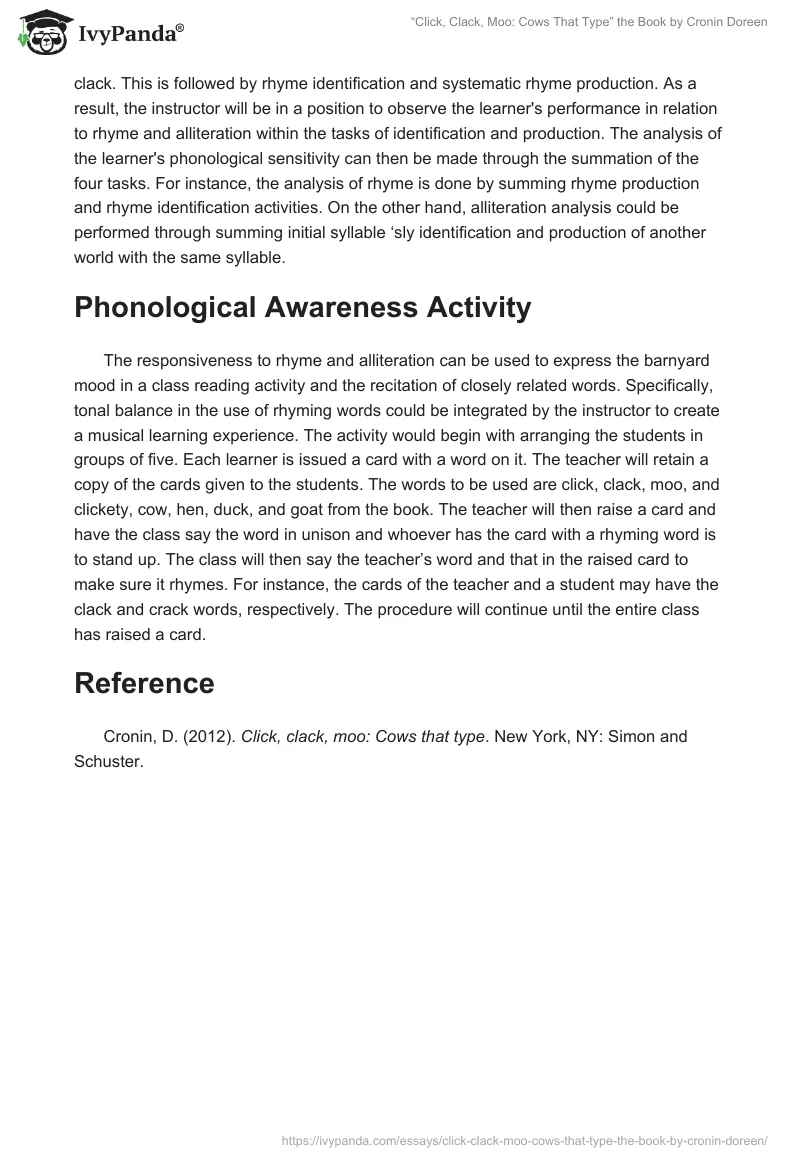Summary
The short book Click, Clack, Moo: Cows That Type by Cronin Doreen is a hilarious short farmyard tale exploring the problems faced by farmer Brown and his typing cows. The story begins with the cows discovering an old typewriter that is used to pass notes to the dismayed farmer. He could not believe the ‘click, clack, moo’ sound was coming from his hens and cows who were leaving funny silent protest notes.
The short notes carried messages about what the cows wanted to be changed. The problems are further expanded when the cows become contentious. For example, one of the notes read, “The barn is very cold at night. We’d like some electric blankets” (Cronin, 2012, p. 6). Farmer Brown then faced the wrath of the cows and hens upon failing to heed to their demand, and he could not get milk or eggs. With the help of a duck, the conflicting parties reach an agreeable compromise, and the cows and hens actually get their blankets. However, the story takes another twist when the neutral duck decides to take off with the typewriter. The beleaguered poor farmer’s troubles increased following the action of the duck.
Identification, Description, and Definition of Phonological Awareness
Phonological awareness is responsiveness to rhyme and alliteration. The concept of responsiveness to rhyme involves the repetition of initial consonant sounds of neighboring syllables or words such as click and clack. For example, alliteration occurs because click and clack have similar first consonant sounds. For instance, “All day long he hears click, clack, moo. Click, clack, moo. Clickety clack moo” (Cronin, 2012, p. 3). The aspect of phonological sensitivity to rhyme can then be accessed through the implementation of alliteration and rhyme contained in the sequential consonant sounds in click and clack. The first task is the identification of the initial syllable followed by the production of a word or words with a similar syllable, which in this case is ‘cl’ in click and clack. This is followed by rhyme identification and systematic rhyme production. As a result, the instructor will be in a position to observe the learner’s performance in relation to rhyme and alliteration within the tasks of identification and production. The analysis of the learner’s phonological sensitivity can then be made through the summation of the four tasks. For instance, the analysis of rhyme is done by summing rhyme production and rhyme identification activities. On the other hand, alliteration analysis could be performed through summing initial syllable ‘sly identification and production of another world with the same syllable.
Phonological Awareness Activity
The responsiveness to rhyme and alliteration can be used to express the barnyard mood in a class reading activity and the recitation of closely related words. Specifically, tonal balance in the use of rhyming words could be integrated by the instructor to create a musical learning experience. The activity would begin with arranging the students in groups of five. Each learner is issued a card with a word on it. The teacher will retain a copy of the cards given to the students. The words to be used are click, clack, moo, and clickety, cow, hen, duck, and goat from the book. The teacher will then raise a card and have the class say the word in unison and whoever has the card with a rhyming word is to stand up. The class will then say the teacher’s word and that in the raised card to make sure it rhymes. For instance, the cards of the teacher and a student may have the clack and crack words, respectively. The procedure will continue until the entire class has raised a card.
Reference
Cronin, D. (2012). Click, clack, moo: Cows that type. New York, NY: Simon and Schuster.


